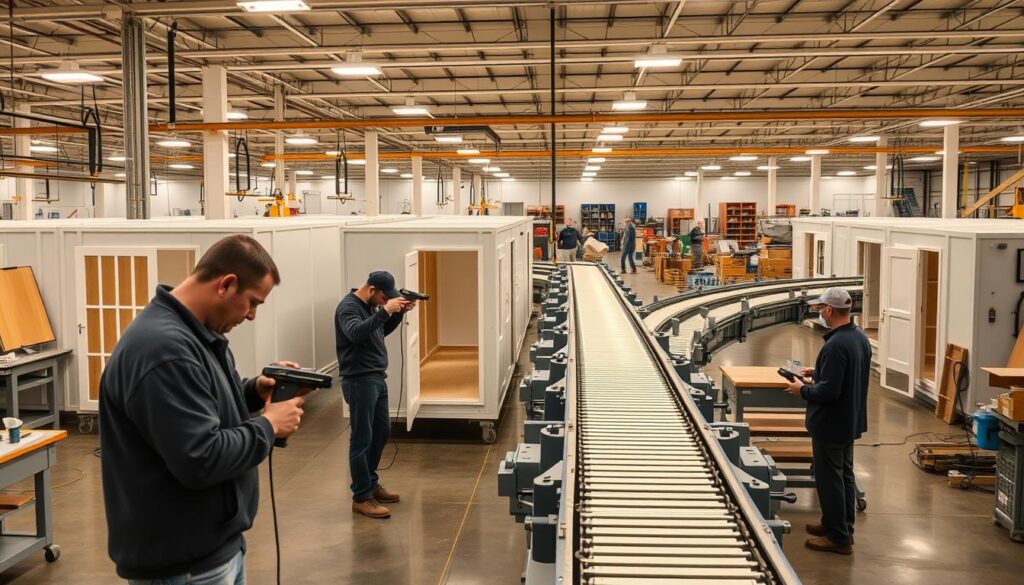Our first visit to a modular build site was exciting. We saw the promise of quick delivery and clean sites. But we also noticed projects delayed by avoidable mistakes.
Modular construction in NSW has many benefits. It ensures quality, meets timelines, and reduces weather risks. However, these advantages are lost when clients make common errors during the selection process.
This guide highlights the five mistakes that can lead to budget overruns, delays, and lower asset value. We provide steps to avoid these issues when choosing a prefab builder. This way, you can protect your project's timeline, budget, and resale value.
We talk about the big problems that can happen on a modular project in New South Wales. Even small mistakes can lead to financial issues, delays, and a loss of value. That's why it's crucial to plan carefully and choose an experienced prefab builder.
Not being clear about what's included can lead to higher costs. Builders might quote for the factory work but not for transport or site work. This can cause unexpected bills and cost overruns for clients in NSW.
Lenders might ask for more money or need to refinance if costs go up. Developers could see their profits shrink. For those buying a home, there could be disputes over bills and delays in getting the keys.
We advise on a detailed scope, budgeting for extras, and clear rules for changes when picking a prefab builder.
Delays in the factory, transport issues, and council approvals can all cause problems. If a module is late, it can push back the completion of the project.
Developers might miss out on rental income or sales targets. Costs like holding fees and interest keep adding up. We suggest setting milestones in contracts, clear roles for approvals, and penalties for delays.
Bad workmanship or poor weatherproofing can make a home harder to sell. Using materials that don't meet standards can lead to insurance and lending issues. These problems can affect the value of the property over time.
Good warranties, third-party checks, and inspections help ensure quality. For those buying or investing in a modular home in NSW, checking materials, certifications, and warranties early on is key to protecting the property's value.
We focus on clear plans, realistic timelines, and quality checks. This approach helps manage costs, avoid delays, and protect the value of the property when choosing a modular home builder in NSW.
We explain the main delivery methods so you can pick the right one. It's about matching your risk level and business goals. Knowing how factory work, transport, and on-site work affect cost, time, and quality is key.
Factory-built sections are big modules ready to stack and connect. They speed up the build and ensure quality in the factory.
Panelised systems come flat or as wall systems for assembly on-site. They offer design flexibility and are easier to transport in NSW.
Trade-offs to weigh:
Turnkey modular NSW contracts include design, factory work, transport, site work, and finishing. It offers a single point of contact and less coordination for clients.
Supply-only deals mean clients or their builders handle site work, services, and trades. This option is good for developers with strong teams to manage costs.
Key considerations:
Costs include transport permits, craneage, site prep, utility connections, and on-site finishing. Each part changes with the model chosen.
Risk sharing is crucial. Clearly state who covers transport damage, on-site issues, and council compliance. Contracts should reflect this.
We suggest matching the delivery model to your team's skills. If you lack project management, turnkey is safer. If you have skilled teams, supply-only can save money.
We start with a simple checklist to reduce risk when choosing a prefab builder. Small steps up front stop costly modular build mistakes later. Ask for documents, follow up with independent checks and record everything you see.
Where do we begin checking licences NSW? Verify the builder licence on the NSW Fair Trading portal. Confirm licence class, scope and expiry date. Match the ABN or ACN against the company listed on the portal.
Look up the principal contractor names and confirm they are registered. Check for any disciplinary history or recorded complaints. Keep screenshots and licence copies for your project file.
Ask for certificates for public liability, workers’ compensation and Home Building Compensation (HBC) insurance if the work exceeds the threshold. Request current policy numbers and insurer contact details.
Clarify who provides transport and installation cover for modules in transit and during craning. Confirm factory QA warranties and statutory implied warranties under the Home Building Act. Get warranty terms in writing.
Which references do we need? Request at least three recent NSW project references and arrange site visits. Inspect completed homes to check finish, durability and council compliance.
Ask for factory QA procedures, sample QA reports and ISO certification where applicable. Confirm experience with local councils, bushfire zones and coastal exposure. Check how they handle disputes and warranty claims.
Before signing, obtain copies of licences, certificates of insurance and a draft contract. These items reduce the chance of modular build mistakes and give confidence when selecting a modular home builder nsw.
| Checklist item | What to verify | Why it matters |
|---|---|---|
| NSW Fair Trading licence | Licence class, expiry, ABN/ACN match | Confirms legal authority to build and scope of permitted work |
| Insurance certificates | Public liability, workers’ comp, HBC, transport cover | Protects you from liability, worker injuries and module damage |
| Project references | Contact details, recent NSW builds, site visit | Shows real-world delivery and finish quality |
| Factory QA evidence | QA reports, ISO or equivalent, sample checklists | Reduces defects and supports consistent workmanship |
| Warranty terms | Duration, coverage, claim process | Ensures remedies for defects and structural issues |
| Local experience | Council approvals, bushfire/coastal projects | Helps navigate approvals and site-specific design needs |
We stress the importance of local knowledge when choosing a modular home builder in NSW. A team familiar with local rules and site limits can save time and avoid delays.
Local knowledge means faster approvals and better site plans. It also means less chance of unexpected costs. Builders with local connections can handle issues more efficiently.
It's wise to look at completed projects similar to yours. This helps avoid mistakes like the wrong module size or finishes not suitable for coastal areas.
What rules affect your project? DA and CDC rules differ by council. BASIX and bushfire requirements can change what materials you use.
The NSW climate affects your choices. Coastal areas need special cladding to resist salt and UV. Bushfire zones require specific window and eave designs.
Site constraints also play a role. Steep terrain and narrow access affect how modules are delivered. Local builders plan for these challenges before starting.
Where can you find reliable builders? Use NSW Fair Trading and industry associations to find them. Attend events to see their work and meet suppliers.
Ask homeowners about their builder's warranty and energy efficiency. Check the finished homes for quality and how well they stand up to the local climate.
When picking a prefab builder, ask for references and photos. This ensures they have the local expertise you need and can avoid common mistakes.
Choosing a prefab builder means understanding the contract. It outlines who does what, when, and for how much. Without clear details, projects can face cost overruns and delays. We'll cover common mistakes and essential clauses to keep your NSW project on track.
It's crucial to know what's included in the scope. Ambiguous descriptions can lead to disputes. We suggest a detailed scope schedule that lists every task.
Break down the scope into factory work and onsite tasks. Use a responsibility matrix to clarify who does what. Include a list of fittings and fixtures to avoid unexpected costs.
Make sure exclusions are clear. State what's not included, like landscaping or council fees. This helps avoid costly surprises after signing.
Large upfront payments can be risky. Clients may lose money if progress isn't verified.
Staged payments tied to milestones are safer. This includes design approval, factory completion, and final delivery. Keep a retention amount for any defects.
For big payments, consider escrow or bank guarantees. This protects your money and aligns interests with the builder.
Informal changes can lead to cost disputes. A formal process is needed. This includes written approvals and defined costs.
Have clear steps for resolving disputes. Start with a project manager review, then mediation, and finally expert determination. Specify NSW law and require insurance and performance bonds when necessary.
Getting legal advice is wise. It helps avoid costly disputes and ensures your contract is solid.
Key contract checks include detailed scopes, clear responsibilities, staged payments, and escrow or guarantees. Also, have formal change order rules and a clear dispute resolution path under NSW law.
Planning a modular project in New South Wales requires early site and regulatory checks. These steps save time and money. Common mistakes include missing council requirements NSW or underestimating transport logistics NSW. A systematic approach is key, starting before manufacture and continuing through installation.

Choosing the right planning pathway is crucial. Development Applications (DA) and Complying Development Certificates (CDC) vary by council. Some sites need a DA, while others can use a CDC. Overlays, module size, placement, and materials can also be restricted.
BASIX and energy requirements must be sorted out early. This ensures compliance with regulations.
We have pre-lodgement meetings with councils to identify constraints early. This step reveals overlays, heritage controls, and specific documentation needs. It also clarifies the need for a DA or CDC and any additional reports required.
Working with a modular home builder nsw familiar with local practices speeds up approvals. Their experience helps avoid costly rework due to non-compliant documentation.
Transport limits affect module size and delivery timing. We check road widths, bridge load limits, and permit requirements for oversized loads on NSW roads. Escort vehicle needs and travel windows impact cost and schedule.
Crane logistics require an on-site assessment of set-down area, ground-bearing capacity, and nearby powerlines. Noise, parking, and neighbour access need management plans. Early engagement with crane and transport providers prevents last-minute changes.
Geotechnical reports reveal weak soils that may require piling or special footings. These findings can change module connection details and increase budget. Flood-prone sites need raised floor levels, enhanced waterproofing, and different insurance treatments.
In bushfire-prone areas, BAL ratings dictate materials, glazing, and ventilation strategies. Modular manufacturers must include BAL-compliant detailing in factory work to avoid costly on-site modifications.
Practical checklist we use:
Projects often stall due to missed communication and governance steps. Clear protocols help avoid common modular build mistakes. They also protect timelines, budget, and quality. We use certain practices to keep clients informed and in control during modular delivery.
Setting clear communication protocols
We establish single points of contact for all parties. This includes the client, the modular home builder nsw, the factory, and the site supervisor. It ensures messages are clear and decisions are traceable.
We agree on communication channels beforehand. This includes email for records, a project management platform for tasks, and weekly meetings for issues. All changes are documented in writing to prevent future disputes.
Using progress milestones and reporting tools
We use digital platforms like Procore or Aconex for logging RFIs, approvals, photos, and QA checklists. This method reduces prefab project management errors by making evidence easily accessible.
Milestones must be measurable. This includes design sign-off, factory start, factory completion, delivery, placement, and practical completion. Regular status reports highlight any schedule or budget variances, allowing for early risk identification.
Who manages on-site integration and trades coordination
Turnkey contracts usually include on-site coordination. For supply-only arrangements, we appoint an experienced site integration manager. This person handles craning, tie-ins, and finishing trades. Without this role, modular build mistakes increase significantly.
We define roles for snagging, final inspections, and handover documentation before modules arrive. This clarity speeds up problem resolution and protects the client’s interests during prefabrication and on-site work.
Quality controls in modular building are essential. They ensure budgets are protected and mistakes are minimised. This avoids the need for costly rework.

What should we expect from factory QA NSW? Look for written checklists, material traceability logs, and dimensional control records. Also, expect moisture/thermal test results. Ask for ISO 9001 or similar evidence and QA records for each project stage.
Which independent checks add value?
When should inspections occur?
What should we include in contracts? Require a detailed QA register as a deliverable. Demand documented sign-offs from the builder and independent inspectors. Keep a project file of QA NSW records and all third-party inspections. This supports warranty claims and final certification.
Many clients think modular homes mean endless custom options. This leads to mistakes and extra costs. Knowing what designs work with factory systems saves money and time.
When picking a prefab builder, start with a clear design plan. Talk to the modular home builder nsw or manufacturer early. This avoids costly changes due to transport limits and factory constraints.
Common assumptions about flexibility and bespoke options
Design features that add cost or complexity
How to balance personalisation with modular efficiencies
| Design Choice | Impact on Cost | Effect on Schedule | How to Mitigate |
|---|---|---|---|
| Large cantilevers | High—requires extra structure | Adds engineering and crane time | Limit span, use localised steel details |
| Extensive glazed façades | Moderate to high—custom frames | Longer lead times for glazing | Standardise frame sizes, use repeatable modules |
| Unusual roof forms | High—breaks standard jigs | Complicates factory workflow | Integrate roof geometry into module grid early |
| Services between modules | Moderate—additional detailing | Requires coordination, may delay handover | Map services at schematic stage, use service collars |
| Special finishes or imports | Variable—depends on material | Potential factory scheduling delays | Specify local alternatives or order early |
Budgets often seem fine until extra costs pop up. Siteworks, services, and transport can add up quickly. A detailed checklist helps keep projects on budget and on time.
What is commonly missed in quotes?
How should we plan contingencies?
How to compare like-for-like quotes?
Practical actions we recommend
We've outlined the steps to avoid common modular build mistakes. These mistakes can increase costs and delay projects. Make sure to check the builder's licences and insurance.
Choose a delivery model that fits your needs. Read contracts carefully and confirm site and council requirements early. These steps help reduce risks and make better choices.
Insist on high-quality assurance and realistic budgets. Ask builders direct questions and request proof of their work. If you can't manage projects, choose a turnkey arrangement.
For those who can manage trades, a supply-only option might save costs. This advice helps make prefab projects predictable.
Use our checklists for licence checks, site assessments, and contract reviews. Get legal and technical advice early for NSW modular projects. We're here to help you compare builders, review contracts, and set up project controls.


